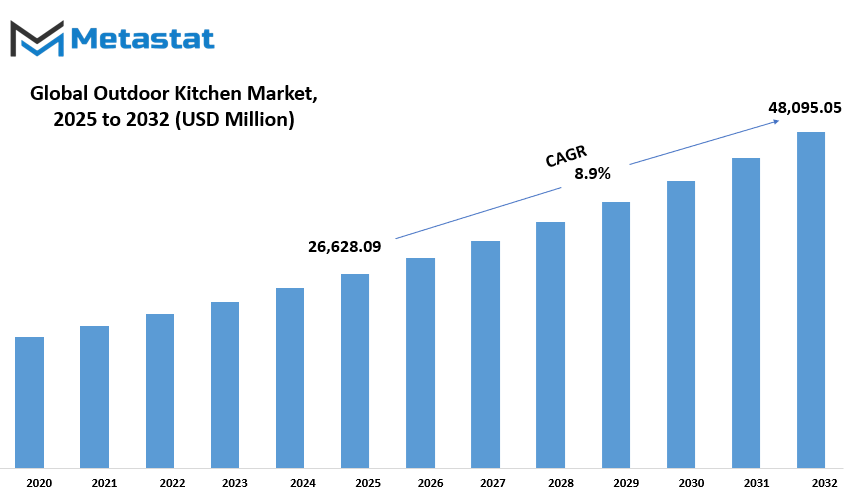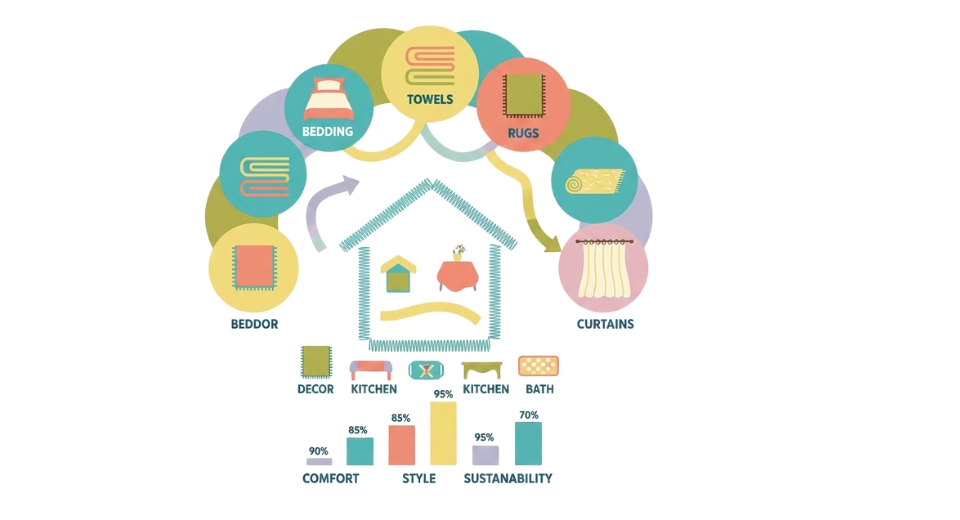MARKET OVERVIEW
This is expected to bring a huge change in the outdoor kitchen market, which has been in trend these days around the world. With changing trends, more people will start realizing the concept of bringing life to an extension of living space outdoors. More and more individuals will look forward to upgrading their outdoor living experiences with this market. Outdoor kitchens have become something much more than what originally was a simple grill setup.
Outdoor is now a full-functional and stylish extension of the inside kitchen as more and more spaces are integrated into modern homes. Diverse shifts will be experienced in this market as people will be looking for various products, not only functional and more reflective of personal style. Customization will emerge as one of the most outstanding changes in the global outdoor kitchen market.
A demand for something different and personal in outdoor space is what more consumers are trying to achieve by having custom-built kitchens. In addition to the standard built-in grills, outdoor refrigerators, and sinks, people will seek innovative features such as outdoor pizza ovens, fire pits, and even wine coolers to create a true culinary escape in their backyard. The personalization of outdoor kitchens will extend beyond functionality, with a strong emphasis on aesthetic appeal.
That is, homeowners will focus on stainless steel, granite, and marble for exterior kitchen production in order to ensure that their outdoor kitchens will be marvelous in sight while still being comfortable and suitable for cooking and entertaining. Customization and sustainability are the most important factors in shaping the outdoor kitchen market around the world. With the ever-increasing concern for the environment, consumers will be attracted towards material that can help to reduce wastes.
This will comprise energy-efficient appliances, sourced materials from sustainable practices, and outdoor kitchen arrangements towards the reduction of waste and consumption of energy. For instance, the use of solar-powered lighting for outdoor facilities, water-conserving fixtures, and energy-draining appliances reducing carbon footprints will be made more frequently. The change will symbolize the larger trend of mindful consumerism as people become more aware of the environmental costs of their purchases.
The technological changes in the outdoor kitchen space will continue to redefine what it means to cook outside. As smart home technology is increasingly integrated into daily life, outdoor kitchens will no longer serve as just grilling and casual cooking spaces. The future will bring smart outdoor appliances that allow users to control their kitchen systems remotely, whether it’s adjusting the temperature of an oven or monitoring the cooking process from a smartphone.
This fusion of convenience, technology, and outdoor living will significantly shape the global outdoor kitchen market. Regional preferences would likewise drive the design and functionality of outdoor kitchens as the global outdoor kitchen market expands. For instance, warmer climates might focus more on shades while colder regions have greater demands for heating solutions through outdoor heaters and fire pits. This will offer brands avenues to respond to specific needs, thereby helping it to serve its target demographics better.
Looking forward, the outdoor kitchen market will be set for a future where innovation and design meet to create highly functional, stylish, and sustainable outdoor cooking spaces. This change in consumer behavior is expected to come from a desire for more seamless integration between indoor and outdoor living. As more people will be willing to invest in the outdoor spaces around their houses, the demand in the market will continue to escalate for more modern kitchen solutions which enable the possibility of experiencing outdoors in comfort and style.
Global Outdoor kitchen market is estimated to reach $48,095.05 Million by 2032; growing at a CAGR of 8.9% from 2025 to 2032.

GROWTH FACTORS
The Global growth in the outdoor kitchen market is highly driven by the increasing demand of outdoor spaces and house improvement. Outdoor living spaces have now become a necessity for comfort, functionality, and aesthetics in the backyard. An important factor that fuels the growth of the market is extension of the dwelling area from four walls. People are spending more time outdoors, whether for family gatherings, social events, or just enjoying their free time, and an outdoor kitchen adds both convenience and luxury to these experiences.
Another key driving factor is the growing consumer preference for luxurious and customizable home amenities. Homeowners today want personalized spaces that reflect their unique tastes and cater to their specific needs. It will enable them to decide on every aspect from layout to appliances and materials, hence a chance to design an area according to lifestyle. Be it a small patio or a garden of sizeable proportion, it can add that luxurious feel of exclusivity in the house for it to become a valuable investment.
Outdoor kitchens have challenges though in the market. The major drawbacks toward wide adoption involve high installation and maintenance costs. High-quality construction of an outdoor kitchen requires financial investment in procuring durable material as well as skilled professionals who install it, making the upfront costs quite challenging. Some budgets will be difficult to accommodate high expenses for purchasing outdoor kitchens with materials that must endure weather patterns. Extreme temperatures, rainfall, and high humidity can harm equipment and surface finishes, requiring homeowners to exercise more caution and spend more in choosing weather-resistant materials.
Challenges notwithstanding, innovation in designs for weather-resistant and modular outdoor kitchens offers big opportunities for the market in coming years. As technological advancements continue to advance, producers are producing materials and products that are better able to prevent harsh weather conditions and offer more flexible and modular designs. This makes it easier for homeowners to customize their outdoor kitchens according to their specific needs and preferences while reducing concerns over durability. These innovations are expected to open up new possibilities for outdoor kitchen designs, attracting more homeowners and driving growth in the market.
MARKET SEGMENTATION
By Type
Significant growth in the market of the outdoor kitchen can be observed as individuals have grown and have demanded much more demand to create space within the premises with advanced cooking options. Because today people have maximum time for recreation and amusement so that it helps increase outdoor living space demands by popularizing it and gaining widespread interest and further support by boosting their preference, hence promoting further.
This market is highly diversified as many different types of products meet up with diverse kinds of needs and preferences. Segments that mainly make up the market are the grills and barbecues, outdoor refrigeration units, outdoor sinks and faucets, outdoor storage solutions, and the modular kitchen islands.
The primary products under the outdoor kitchen category are grills and barbecues. They are an excellent method to prepare food in the open and ensure the consumers are able to savor mouthwatering food items under the sky. The market value of the industry has stood at $11,228.89 million due to grills and barbecues. Various grills, including gas, charcoal, and electric models, are increasingly demanded as consumers try to have more variety in enhancing their outdoor cooking experiences.
Outdoor refrigeration units form another indispensable segment in the market for outdoor kitchens. As its name suggests, it is the keystone to keeping food and drinks cool while outdoors. This is convenient, hence adding more value to all perishable products that will be used in the kitchen. Due to growing demand in terms of outdoor cooking and dining, outdoor refrigerators have become a necessity with regard to homeowners seeking to enhance outdoor kitchens.
There is also a popularity of outdoor sinks and faucets as part of outdoor kitchen installations. These allow easy access to water for outdoor cooking, cleaning, and all other outdoor uses. They are designed to work well in the outdoors and deliver functionality and durability. Outdoor sinks and faucets add to the overall convenience and usability of an outdoor kitchen.
Outdoors, storage solutions for the kitchen tool, utensils, and other equipment are necessary because some of the items are used for outdoor cooking. This would include cabinets and shelves, as well as storage units specifically designed to withstand the elements. These outdoor kitchens maintain neat and organized places with everything one could want at hand when needed.
Another important aspect of the outdoor kitchen market is modular kitchen islands. These islands can be customized according to the requirements of the homeowner, and they offer more counter space for food preparation and storage, which also makes them a great addition to any outdoor kitchen setting. Modular kitchen islands are growing in demand because people want flexibility and stylishness for their outdoor spaces.
As the demand for outdoor kitchens rises, this demand will result in an increased level of such products, hence allowing consumers a vast array of options to spice up their outdoor cooking experiences.
By Material
The global outdoor kitchen market is on the rise, and various materials are playing an important role in this growth. The market can be divided into three major groups based on materials: stainless steel, stone, and wood. Each of these materials has a different set of benefits, making them popular with consumers who seek to create their dream outdoor kitchen spaces.
Stainless steel is one of the most preferred materials in the setting up of outdoor kitchens, and why not, as its durability goes well with the sleek appearance. This material has weather resistance in the form of moisture as well as the changes in temperature, making it ideal for the outside. Not to mention that stainless steel requires minimal maintenance. Another reason for its popularity is that it does not rust and corrode, especially in moist or salty air. In addition, its modern look complements various outdoor designs, from contemporary to minimalist settings.
The most commonly used material for an outdoor kitchen is stone. Stone is strong and resilience-based and can withstand harsh weather conditions, ranging from extreme heat and heavy rainfall. It also boasts outstanding heat resistance; therefore, the material is a perfect fit in areas where one cooks directly contacting high temperatures during grilling, for instance.Stone outdoor kitchens have a nostalgic look that often blends well with the natural environments, thus attracting more people towards it. Secondly, stone has the ability of being used flexibly, say from countertops to backsplashes and even as a full kitchen structure outdoors hence giving the users many design choices.
The third material to be used widely in outdoor kitchens is wood. Wood provides the warm, rugged look that perhaps stainless steel or stone cannot achieve. It has higher maintenance needs than stainless steel or stone, but it offers a unique personal feel to outdoor living spaces. Wood, and more so the hardwoods, are strong material, which withstands outdoor elements with proper sealant and protection. Wood has an appeal in that it creates an atmosphere that is cozy and inviting. It can be used from cabins to countertops and decking, allowing homeowners to maintain a unified look with natural surroundings. A caution, however, is that wood can be difficult to deal with as it may easily damage due to exposure to rain and, most significantly, sun.
In conclusion, the outdoor kitchen market is diverse in stainless steel, stone, and wood, as each has advantages that are specific to it. Stainless steel will be preferred by most for durability and easy upkeep, while strength and a never-ending look in stone will also be valued. Wood, however, requires a bit more care but brings that natural and warm feel to any outdoor space. Each material would suit different tastes, and customers will choose depending on their needs for aesthetic or functional purposes.
By Sales Channel
The steady growth of the global outdoor kitchen market is due to rising interest in outdoor living spaces and home improvement. With an outdoor kitchen, home owners entertain their guests, cook their meals, and spend time outside in a much more convenient manner but in style. The outdoor kitchen market is divided into various segments based on the most important sales channel. These sales channels are the outdoor kitchens' direct sources to reach their consumers and three common forms are shown as specialty stores, retail websites and big-box retailers.
Specialty stores are one of the major channels of sales for outdoor kitchens. Specialty stores deal with a particular product line, such as outdoor kitchen equipment and accessories, that offer specialized products to customers seeking quality and variety. Customers like to shop in specialty stores because they offer the best guidance and hands-on experience while shopping. They can also offer specialty outdoor kitchen products that are quite exclusive and can't be easily found in any other store type. Specialty stores allow for the personalization of a shopping experience by asking questions, seeing things in person, and getting a tailored recommendation from a buyer. For many, the ability to speak directly to knowledgeable staff about the best products for their needs makes this channel a preferred choice.
Online retail has also become a major player in the outdoor kitchen market. The rise of e-commerce has changed the way people shop for products, including outdoor kitchen items. Consumers can see and buy outdoor kitchen products from their homes by comparing prices, reading reviews, and finding exactly what they want. Online stores enable one to shop at any time and get a wide variety of products such as those from international brands. Additionally, most online platforms also offer home delivery, which is enhancing their convenience for the customers. This has meant that consumers would be able to buy outdoor kitchen equipment from the comfort of their homes with no physical store visit.
Big-box retailers are also a significant player in the outdoor kitchen market. Big-box retailers include large, high-volume retail chains whose breadth of products is generally larger and whose prices are competitive. They serve many different customers, and their assortments are wide, general merchandise. Big-box retailers make it very easy for consumers to find outdoor kitchen items amongst other home goods, which attracts buyers seeking convenience. They typically have large physical locations and therefore offer a great deal of room for displaying outdoor kitchen products. Their ability to stock large quantities of items and offer discounts has made them the first choice of many customers.
In summary, three major sales channels shape the outdoor kitchen market: specialty stores, online retail, and big-box retailers. Each of these channels has a unique purpose and allows customers to experience different shopping experiences based on their preferences, convenience, and needs.
By End User
The global outdoor kitchen market has gained a great pace in recent years, based on several driving factors such as increasing preference towards living spaces and culinary experiences within the outdoor environments. This market can be further bifurcated into two primary categories: residential users and commercial users that include hotels, restaurants, and event spaces.
The largest category of the outdoor kitchen is residential users. As people are mostly staying indoors these days, there has been a mass migration toward designing outdoors as useful and pleasingly aesthetic. Large numbers of home owners have been investing in outdoor kitchens to enhance their life experience out in the open. With an outdoor kitchen, they can take their time with guests, prepare meals, and enjoy cooking outdoors. The outdoor kitchens provide various appliances that may range from grills to refrigerators and sinks along with countertops to enable convenient comfort under relaxed outdoor ambiances. Thus, such requirements for such kinds of kitchens would further be required in future with an increased percentage of home environmental improvements.
Commercial users also expand the outdoor kitchen market since their usage can also be counted towards hotel or restaurants, even venues of an event. For businesses, outdoor kitchens are now part of their activities, especially for places with conducive weather where al fresco dining is in vogue. Hotels and restaurants have been designing open-air kitchens for the purpose of offering their clients an exclusive experience. Event venues also have such kitchens to cater to big gatherings and outdoor events, like weddings and corporate events. These outdoor kitchens are geared toward large-scale food preparation, and most of them have industrial-level appliances plus features that can deal with high volumes of cooking and service.
Additionally, increasing interest in outdoor living and dining as a lifestyle trend for residential as well as commercial purposes fuels the growth of the global outdoor kitchen market. More consumers are now acknowledging the importance and value of outdoor space. Thus, demand is continually rising for efficient, durable, and fashionable outdoor kitchens. This market will continue to grow because both residential and commercial users will search for ways to advance their outdoor experience with versatile and appealing kitchen setups.
|
Forecast Period |
2025-2032 |
|
Market Size in 2025 |
$26,628.09 million |
|
Market Size by 2032 |
$48,095.05 Million |
|
Growth Rate from 2024 to 2031 |
8.9% |
|
Base Year |
2024 |
|
Regions Covered |
North America, Europe, Asia-Pacific, South America, Middle East & Africa |
REGIONAL ANALYSIS
The outdoor kitchen market around the globe has been segmented based on geographic regions. The major areas are North America, Europe, Asia-Pacific, South America, and the Middle East & Africa. In North America, the market has been bifurcated into the U.S., Canada, and Mexico. All of these countries have their individual preferences and trends toward outdoor cooking and kitchen setting. For instance, the U.S. is dominated by a large demand for premium outdoor kitchen appliances, whereas the Canadian market depends on its more frigid weather conditions and would likely have higher seasonal outdoor kitchen usage.
Another significant region of the outdoor kitchen market is Europe. This consists of the UK, Germany, France, Italy, and the rest of Europe. The UK is witnessing a growing interest in outdoor kitchens, especially in urban areas where people are looking to make the most of their outdoor spaces. Germany and France are also witnessing steady growth in this market, with people focusing on durable and high-quality kitchen setups. Italy, known for its rich culinary heritage, has a particularly strong demand for outdoor cooking equipment, focusing on style and functionality.
The Asia-Pacific region, that include India, China, Japan, South Korea, and the rest of Asia-Pacific, has been proving to show a trend for outdoor kitchen driven by an increasing number of people dwelling in urban areas as well as the wanting of more out-of-door living spaces. In countries such as Japan and South Korea, outdoor cooking is emerging as the new rage with compact efficacious designs. India and China are primarily driven by an increase in disposable incomes and by a growing interest in modern techniques and appliances used in cooking.
In South America, outdoor kitchens are seeing increasing demand across Brazil and Argentina due to their warm climates and the cultural affinity for dining outside. Brazil boasts a significant culture of outdoor kitchen cooking, and most households make an investment in outdoor cooking set-ups for gatherings and barbecues.
Middle East & Africa - The final region is comprised of the GCC countries, Egypt, South Africa, and the rest of the region. The demand is on the rise in GCC countries, more so the UAE and Saudi Arabia. It's driven by the region's affluent population and year-round warm weather. South Africa is a growing outdoor kitchen investment driven by greater attention to outdoor living spaces through warm and cool climate.

COMPETITIVE PLAYERS
The global outdoor kitchen market has experienced a sharp rise in the past few years, with growth being attributed to the rising need for outdoor cooking and entertainment. As people increasingly spend time indoors and try to improve their living spaces outdoors, outdoor kitchens are becoming a standard feature. They are built to provide the amenities and functionality of an indoor kitchen but still provide the freedom of being outdoors. The market of outdoor kitchens is very diversified because of the product variety that meets the needs of different customers in terms of demand and preference.
The major players in the outdoor kitchen market include the best-of-breed names like Weber Inc., Lynx Grills, Napoleon Products, Viking Range, LLC, and Bull Outdoor Products. The companies have a long history in the market and provide myriad solutions for outdoor cooking. For instance, Weber Inc. is recognized for its quality grills and outdoor cooking accessories, while Lynx Grills provides high-end premium outdoor kitchens with features for the most discerning consumer.
There are well-known brands, besides Kalamazoo Outdoor Gourmet, LLC and Alfresco Grills, or SES Brands among others available in the market. Each one of these managed to capture their respective market share of outdoor cooking enthusiasts with attractive product innovations. For instance, Kalamazoo Outdoor Gourmet is a well-known one for luxury outdoor kitchens, high-quality materials and state-of-art technology. On the other hand, Traeger Pellet Grills is known for pellet grills. This offers a kind of cooking that is flavored and very easy to use.
In addition, outdoor kitchen market DCS is also a significant contributor to Fisher & Paykel Appliances Limited, offering many built-in appliances and cooking equipment that seamlessly integrate into outdoor spaces. RTA Outdoor Living, Coyote Outdoor Living, Inc., and Blaze Outdoor Products are other key players in the market, each bringing their own expertise in creating high-quality, customizable outdoor kitchens. Summerset Grills is also a prominent brand, offering products that are known for their durability and performance.
These companies are never coming up with new innovations to meet the changing needs and demands of the consumer. Different products such as grills, ovens, refrigerators, sinks, and storage solutions are offered by them. With this expanding market of outdoor kitchen, it can be truly said that these main players will lead and make a future for outdoor cooking and entertainment. In other words, a growing popularity in outdoor kitchens seems to indicate the general direction towards more functional and enjoyable living in the outdoors with companies offering more products to add value both in terms of culinary experience and visual appeal in an outdoor setting.
Outdoor kitchen Market Key Segments:
By Type
- Grills and Barbecues
- Outdoor Refrigeration Units
- Outdoor Sinks and Faucets
- Outdoor Storage Solutions
- Modular Kitchen Islands
By Material
- Stainless Steel
- Stone
- Wood
By Sales Channel
- Specialty Stores
- Online Retail
- Big-Box Retailers
By End User
- Residential Users
- Commercial Users (Hotels, Restaurants, Event Spaces)
Key Global Outdoor kitchen Industry Players
- Weber Inc.
- Lynx Grills
- Napoleon Products
- Viking Range, LLC
- Bull Outdoor Products
- Kalamazoo Outdoor Gourmet, LLC
- Alfresco Grills (SES Brands)
- Traeger Pellet Grills LLC
- Fisher & Paykel Appliances Limited (DCS)
- RTA Outdoor Living
- Coyote Outdoor Living, Inc.
- Blaze Outdoor Products
- Summerset Grills
WHAT REPORT PROVIDES
- Full in-depth analysis of the parent Industry
- Important changes in market and its dynamics
- Segmentation details of the market
- Former, on-going, and projected market analysis in terms of volume and value
- Assessment of niche industry developments
- Market share analysis
- Key strategies of major players
- Emerging segments and regional growth potential








 US: +1 3023308252
US: +1 3023308252






